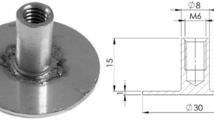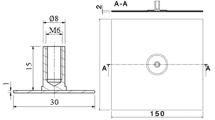Abstract
The combination of construction parts made of fibre-reinforced plastics (FRP) and metal holds great lightweight design potential but places high demands on the necessary joining technologies. Metallic load introduction elements that are embedded in the manufacturing process of FRP components are a promising joining technology. In order to fully exploit the potential of this technology, approaches to increase the load bearing capacity of inserts, particularly under pull-out loads, have been missing. The aim is therefore to derive a method for the simulative structural optimisation of embedded inserts. The load bearing capacity increases under pull-out loads through smoothing of failure-critical stress peaks using the optimisation of the thickness distribution of the insert’s base plate. The increase of the load bearing capacity of the optimised insert geometry is confirmed through experimental validation.











Similar content being viewed by others
References
Jármai K, Betti B (2017) Vehicle and automotive engineering. In: Proceedings of the JK2016, Miskolc, Hungary. Springer, Cham (s.l. ISBN: 2195-4364)
Holmes M (2013) Carbon fibre reinforced plastics market continues growth path. Reinf Plastics 57(6):24–29
Atzeni E, Minetola P, Salmi A (2013) Dimensional analysis of a prototype mould-making process for thermoplastic resin transfer moulding. Int J Adv Manuf Technol 65(1–4):309–317
Kim BJ, Lee DG (2008), Characteristics of joining inserts for composite sandwich panels. Compos Struct 86(1–3):55–60
Schwarz M, Schürmann H, fickel M, Magin M, Peil C (2007) Zur Gestaltung von punktuellen Krafteinleitungen in Faserverbund-Strukturen. Konstruktion 6:90–96
Ferret B, Anduze M, Nardari C (1998) Metal inserts in structural composite materials manufactured by RTM. Compos Part A Appl Sci Manuf 29(5–6):693–700
Hopmann C, Fecher L, Linnemann L, Bastian R et al (2013) Vergleich der Eigenschaften von Onserts und Inserts für eine Großserienfertigung von FVK-Strukturbauteilen, vol 9. Carl Hanser Verlag, WAK, Zeitschrift Kunststofftechnik, Karlsruhe, pp 178–206
Weimer C (2003) Preform-engineering: applied sewing technologies to incorporate part and process functions into dry textile reinforcements. Compos Sci Technol 63(14):2089–2098
Molnar P, Mitschang P, Felhos D (2007) Improvement in bonding of functional elements with the fiber reinforced polymer structure by means of tailoring technology. J Compos Mater 41(21):2569–2583
Herzberg C, Rödel. H, Zhao N, Waldmann M, Zoerner G (2009) Konfektionstechnische Fertigung textiler 3D-Preforms für komplexe Leichtbauanwendungen, vol 12. Chemnitzer Textiltechnik Tagung, Chemnitz, pp 231–235
Gebhardt J, Fleischer J (2014), Experimental investigation and performance enhancement of inserts in composite parts. Procedia CIRP 23(C):7–12
Gebhardt J, Pottmeyer F, Fleischer J, Weidenmann K (2015) Characterization of metal inserts embedded in carbon fiber reinforced plastics in 20th Symposium on composites. Selected, peer reviewed papers from the 20th Symposium on Composites, July 1–3, 2015, Vienna, Austria, Hrsg. C. Edtmaier, Trans Tech Publ, Pfaffikon, pp 506–513
Knops M (2008) Analysis of failure in fiber polymer laminates. The theory of Alfred Puck. Springer, Berlin (ISBN: 978-3-540-75764-1)
Kress G, Naeff P, Niedermeier M, Ermanni P (2004) Onsert strength design. Int J Adhes Adhes 24(3):201–209
Acknowledgements
This paper is based on investigations of the collaborative research program “Schwerpunktprogramm 1712” which is kindly supported by the German Research Foundation (DFG—Deutsche Forschungsgemeinschaft).
Author information
Authors and Affiliations
Corresponding author
Rights and permissions
About this article
Cite this article
Gebhardt, J., Schwennen, J., Lorenz, F. et al. Structure optimisation of metallic load introduction elements embedded in CFRP. Prod. Eng. Res. Devel. 12, 131–140 (2018). https://doi.org/10.1007/s11740-018-0820-5
Received:
Accepted:
Published:
Issue Date:
DOI: https://doi.org/10.1007/s11740-018-0820-5




